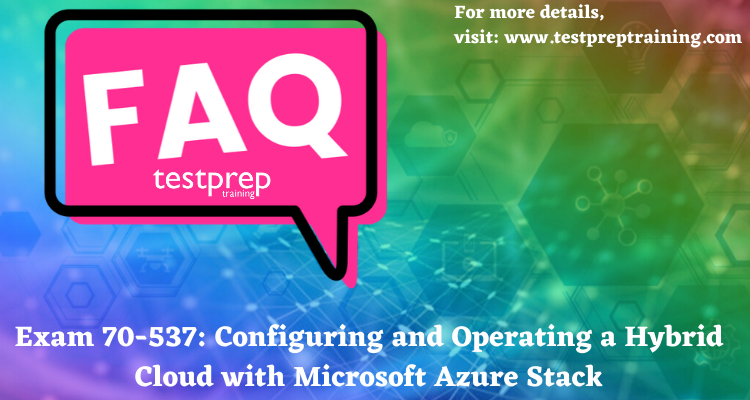Exam 70-537: Configuring and Operating a Hybrid Cloud with Microsoft Azure Stack
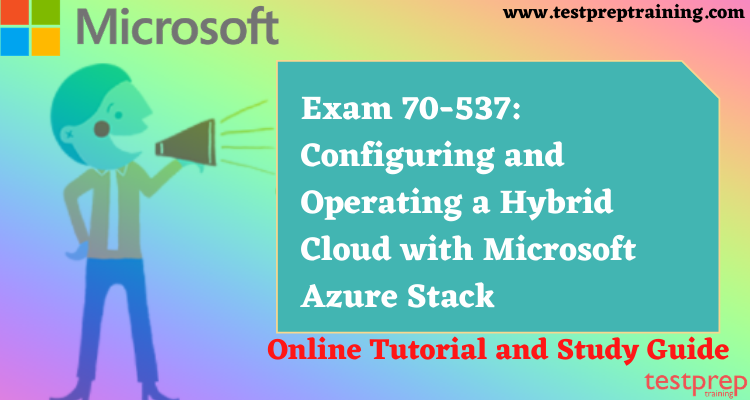
The Exam 70-537: Configuring and Operating a Hybrid Cloud with Microsoft Azure Stack demonstrate the capability to plan, deploy, update, package, and maintain the Azure Stack Hub infrastructure. Candidates must also demonstrate the ability to offer hybrid cloud resources and requested services, and to manage infrastructure as a service (IaaS) and platform as a service (PaaS).
Microsoft 70-537 exam is retired. A new replacement exam Configuring and Operating a Hybrid Cloud with Microsoft Azure Stack Hub Beta (AZ-600) is available.
Candidates for this exam should have significant experience managing and operating Azure Stack Hub environments. Candidates should have a strong understanding of Azure as well as some knowledge of virtualization, networking, and identity management. Candidates should also understand how Azure Stack Hub enables DevOps processes and the hybrid development model.
Target Audience
- Azure administrators
- Azure Stack operators
- IT Professional
- Anyone who wanted to test their knowledge in exam 70-537 Configuring and Operating a Hybrid Cloud with Microsoft Azure Stack.
Learning Objectives
It is beneficial to take a look at the objectives of the exam for which you are preparing. The objectives of Exam 70-537: Configuring and Operating a Hybrid Cloud with Microsoft Azure Stack are:
- Deploying and Integrating an Azure Stack Hub Environment (20-25%)
- Configuring PaaS and IaaS for an Azure Stack Hub Environment (25-30%)
- Providing Services to and Enabling DevOps for Azure Stack Hub Users (25-30%)
- Maintaining and Monitoring an Azure Stack Hub Environment (20-25%)
Learning Path
MCSE certification validates that you have the skills and knowledge needed to run a highly efficient and modern data center, identity management, systems management, virtualization, storage, and networking. The Exam 70-537: Configuring and Operating a Hybrid Cloud with Microsoft Azure Stack is a part of MCSE credential.
To earn the MCSE: Core Infrastructure certification, pass one of the following exams:
- Exam 70-744: Securing Windows Server 2016
- Exam70-745: Implementing a Software-Defined Datacenter
- Exam70-413: Designing and Implementing a Server Infrastructure
- Exam70-414: Implementing an Advanced Server Infrastructure
- Exam70-537: Configuring and Operating a Hybrid Cloud with Microsoft Azure Stack Hub
Exam Details
Explaining the format of Exam 70-537: Configuring and Operating a Hybrid Cloud with Microsoft Azure Stack is the most important step. The exam includes 40-60 number of questions. The questions will appear in the form of multiple-choice. The candidate will get 120 minutes to complete the exam, in total, they get 120 minutes. The exam is available in English. The candidate has to pay $165 USD as the examination fee.
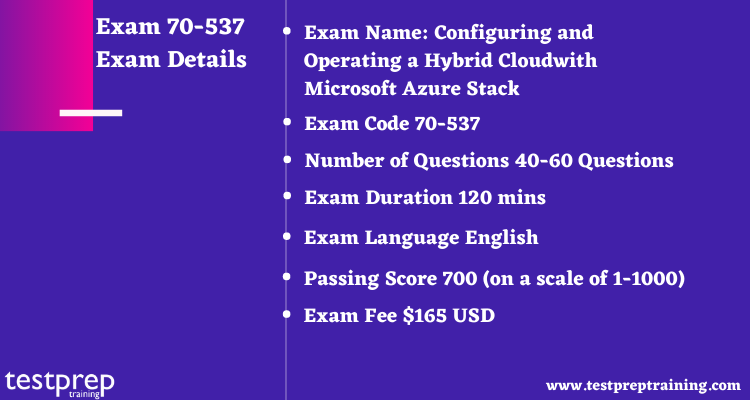
Scheduling the Exam
Pearson VUE 
In order to appear in Microsoft exam, the candidate has to schedule the exam and make themselves register with Microsoft. The candidate can schedule their exam with the Pearson VUE.
Certiport 
The candidate also schedules the Exam 70-537: Configuring and Operating a Hybrid Cloud with Microsoft Azure Stack with Certiport. CLICK HERE FOR SCHEDULING!
Now, that we have acquired all the information related to Exam 70-537: Configuring and Operating a Hybrid Cloud with Microsoft Azure Stack. It’s time for you to understand the Course Outline. The Course Outline forms the most crucial aspect of the examination. So, let’s begin.
Exam 70-537: Detailed Course Outline
As above mentioned, the Exam 70-537: Configuring and Operating a Hybrid Cloud with Microsoft Azure Stack includes planning, deploying, updating, packaging, and maintaining the Azure Stack Hub infrastructure. So, let’s take a look at its main topics. The objectives of Exam 70-537: Configuring and Operating a Hybrid Cloud with Microsoft Azure Stack are:
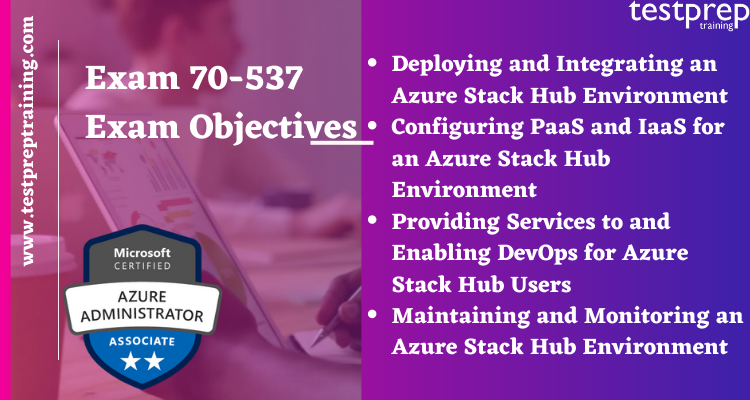
Deploying and Integrating an Azure Stack Hub Environment (20-25%)
Build test environments by using the Azure Stack Hub Development Kit (ASDK).
- use PowerShell commands (Microsoft Documentation: PowerShell)
- install updated ASDK (Microsoft Documentation: Install the ASDK)
- troubleshoot failed installs
- post-deployment registration (Microsoft Documentation: Post-deployment configurations for ASDK)
Configure identity and PKI for data center integration.
- integrate Azure Stack Hub with AD FS (Microsoft Documentation: Integrate AD FS identity with your Azure Stack Hub datacenter)
- create custom RBAC roles for Azure Stack registration (Microsoft Documentation: Create a custom role for Azure Stack Hub registration)
- validate Azure identity, validate AD FS integration (Microsoft Documentation: Validate AD FS integration for Azure Stack Hub)
- validate graph integration (Microsoft Documentation: Validate graph integration for Azure Stack Hub)
- generate PKI certificates (Microsoft Documentation: Generate certificate signing requests for Azure Stack Hub)
- validate PKI certificates (Microsoft Documentation: Validate Azure Stack Hub PKI certificates)
- remediate PKI certificates (Microsoft Documentation: Fix common issues with Azure Stack Hub PKI certificates)
Configure DNS for data center integration.
- configure external DNS name resolution from within Azure Stack Hub (Microsoft Documentation: Azure Stack Hub datacenter DNS integration)
- configure Azure Stack Hub DNS names from outside Azure Stack Hub
Configure connectivity for data center integration.
- manage firewall ports needed at the edge
- configure connectivity to the data center
- install and renew certificates for public endpoints, connect to Azure by using ExpressRoute (Microsoft Documentation: Connect Azure Stack Hub to Azure using Azure ExpressRoute)
Connect to and perform API-based administration on Azure Stack Hub.
- connect to the stack by using PowerShell (Microsoft Documentation: Connect to Azure Stack Hub with PowerShell as a user)
- configure client certificates (Microsoft Documentation: secure back-end services using client certificate authentication in Azure API Management)
- configure the firewall to support remote administration (Microsoft Documentation: Configure Remote Management in Server Manager)
- establish RBAC roles for the Azure Stack Hub fabric (Microsoft Documentation: Azure Stack Hub administration basics)
- create subscriptions for end-users (Microsoft Documentation: Create, suspend, or cancel customer subscriptions)
Configuring PaaS and IaaS for an Azure Stack Hub Environment (25-30%)
Configure and administer the App Service resource provider.
- configure the system
- configure source control (Microsoft Documentation: Use source control integration)
- configure worker tiers (Microsoft Documentation: Add workers and infrastructure in Azure App Service on Azure Stack Hub)
- configure subscription quotas (Microsoft Documentation: Azure subscription and service limits, quotas, and constraints)
- scale worker tiers and App Service infrastructure roles (Microsoft Documentation: Azure App Service on Azure Stack Hub billing overview, Add workers and infrastructure in Azure App Service on Azure Stack Hub)
- add custom software
- configure Azure Stack Hub networking security (Microsoft Documentation: Differences and considerations for Azure Stack Hub networking)
Configure and administer database resource providers.
- configure and administer the SQL adapter (Microsoft Documentation: Deploy the SQL Server resource provider on Azure Stack Hub)
- configure and administer the MySQL adapter (Microsoft Documentation: Add MySQL hosting servers in Azure Stack Hub)
- set up SKUs (Microsoft Documentation: Set Up Stockkeeping Units)
- set up additional hosting capacity
Configure and administer IaaS services.
- implement virtual machine images (Microsoft Documentation: Create a managed image of a generalized VM in Azure)
- prepare Linux and Windows images (Microsoft Documentation: Create a custom image of an Azure VM with the Azure CLI, Bringing and creating Linux images in Azure)
- prepare a custom image (Microsoft Documentation: Create Windows VM images with Azure PowerShell)
- upload an image
Providing Services to and Enabling DevOps for Azure Stack Hub Users (25-30%)
Create and manage quotas, plans, and offers.
- create quotas (Microsoft Documentation: Quota types in Azure Stack Hub)
- configure plans (Microsoft Documentation: Azure Stack Hub services, plans, offers, subscriptions overview)
- configure offers (Microsoft Documentation: Azure Stack Hub services, plans, offers, subscriptions overview)
- configure delegated offers (Microsoft Documentation: Delegate offers in Azure Stack Hub)
- create add-on plans (Microsoft Documentation: Create add-on plans in Azure Stack Hub)
Manage tenants and users.
- configure multi-tenancy in Azure Stack (Microsoft Documentation: Configure multi-tenancy in Azure Stack Hub)
- remove tenants (Microsoft Documentation: Directory Tenants – Delete)
- manage authentication and authorization (Microsoft Documentation: Get authentication information for Azure Stack Hub)
- establish RBAC roles for the user space (Microsoft Documentation: Manage access to resources in Azure Stack Hub with role-based access control)
Manage the Azure Marketplace.
- enable Azure Marketplace on Azure Stack Hub (Microsoft Documentation: Azure Marketplace items available for Azure Stack Hub, Azure Stack Hub Marketplace overview)
- plan new packages (Microsoft Documentation: Azure Stack Hub services, plans, offers, subscriptions overview)
- create and publish new packages
- download Azure Marketplace items (Microsoft Documentation: Download Marketplace items to Azure Stack Hub)
Enable DevOps for users.
- enable version control for users (Microsoft Documentation: Resource provider API versions supported by profiles in Azure Stack Hub)
- enable CLI for users, manage ARM templates (Microsoft Documentation: Manage and deploy resources to Azure Stack Hub with Azure CLI)
- deploy ARM templates (Microsoft Documentation: Deploy a template using the portal in Azure Stack Hub)
- debug ARM templates
- use Azure DevOps to connect to Azure Stack Hub (Microsoft Documentation: Azure Stack Hub overview)
- use continuous integration and continuous deployment to automate a pipeline that targets Azure Stack Hub (Microsoft Documentation: DevOps pattern)
- configure app identity to access resources using Azure AD and AD FS service principals (Microsoft Documentation: Use an app identity to access Azure Stack Hub resources, Use the portal to create an Azure AD application and service principal that can access resources)
Maintaining and Monitoring an Azure Stack Hub Environment (20-25%)
Plan and implement a backup-recovery and a disaster-recovery solution.
- back up Azure Stack Hub infrastructure services (Microsoft Documentation: Enable backup for Azure Stack Hub from the administrator portal)
- perform cloud recovery of Azure Stack Hub, replicate and failover Azure Stack Hub VMs to Azure (Microsoft Documentation: Protect VMs deployed on Azure Stack Hub, Replicate Azure Stack VMs to Azure)
- back up and restore PaaS resource data
- back up and restore a backup and restore of user Azure Stack Hub VM-OS, disks, volumes, and apps (Microsoft Documentation: Back up files and applications on Azure Stack Hub, restore Azure VM data in Azure portal)
Manage and monitor capacity, performance, updates, and alerts.
- manage storage (Microsoft Documentation: Manage storage capacity for Azure Stack Hub)
- monitor available storage (Microsoft Documentation: Use Azure Monitor on Azure Stack Hub)
- integrate existing monitoring services (Microsoft Documentation: Integrate external monitoring solution with Azure Stack Hub)
- manage public IP address ranges (Microsoft Documentation: Add public IP addresses)
- monitor infrastructure component health (Microsoft Documentation: Monitor health and alerts in Azure Stack Hub)
- monitor Azure Stack Hub memory, public IP addresses, and storage user consumption
- apply updates (Microsoft Documentation: Manage updates in Azure Stack Hub)
- update system firmware
- review and react to alerts
- configure external auditing and syslog forwarding (Microsoft Documentation: Integrate Azure Stack Hub with monitoring solutions using syslog forwarding)
- replace hardware (Microsoft Documentation: Replace a hardware component on an Azure Stack Hub scale unit node)
Manage usage reporting and log collection
- provide access to the usage database (Microsoft Documentation: Use SQL databases on Azure Stack Hub)
- test usage by using the ASDK (Microsoft Documentation: Validate Azure Stack Hub system state)
- collect the usage data by using the Provider Resource Usage API and the Tenant Resource Usage API
- investigate the usage time versus the reported time
Microsoft Exam Policies
While preparing for Microsoft Exam 70-537: Configuring and Operating a Hybrid Cloud with Microsoft Azure Stack, you will be completely responsible for knowing and complying with Microsoft Certification exam policies, together with the specified exam delivery provider’s policies and procedures.
Also, you can go through the Exam Retake Policy together with other Microsoft exam available and exam testing procedures. The exam policy page provides details of the exam provider’s policies and procedures together with the exam provider’s details. Note, you will have 30 days after taking an exam to challenge your exam score for that exam.
Exam 70-537: Configuring and Operating a Hybrid Cloud with Microsoft Azure Stack FAQ
Step by Step Preparation Guide to qualify Exam 98-368
To start the ideal preparation for the Exam 70-537: Configuring and Operating a Hybrid Cloud with Microsoft Azure Stack, the following details a few of the critical steps that you should consider for developing an ideal schedule for your Exam 70-537 preparation.
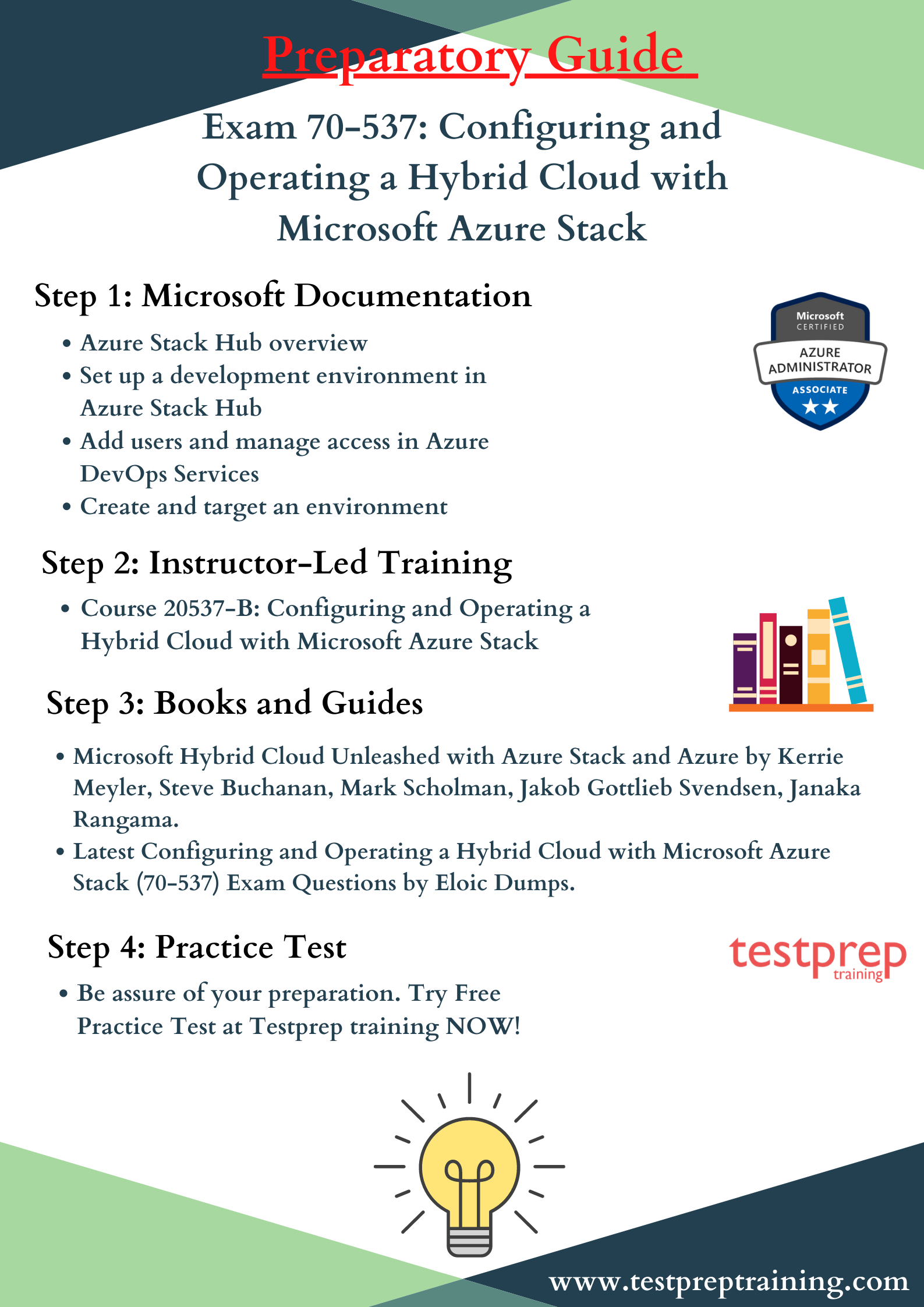
Microsoft Learning Platform 
Microsoft offers various learning paths, the candidate should visit the official website of Microsoft. The candidate can find every possible information on the official site. For this exam, the candidate will find many learning paths and documentations. Finding the relatable content on the Microsoft website is quite an easy task.
Microsoft Documentation 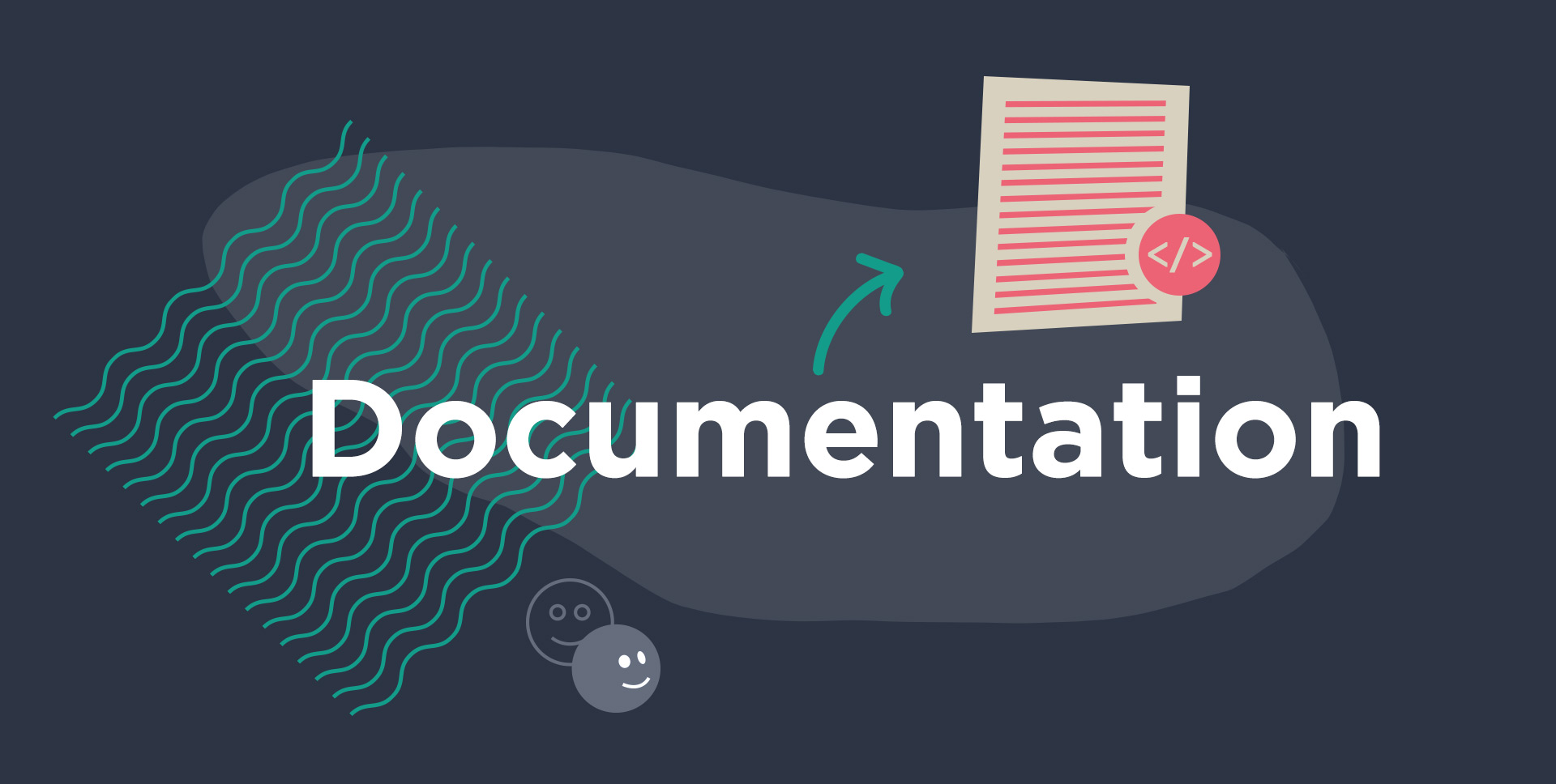
Microsoft Documentations are an important learning resource while preparing for Exam 70-537: Configuring and Operating a Hybrid Cloud with Microsoft Azure Stack. The candidate will find documentation on every topic relating to the particular exam. This step is very valuable in preparing for MCSE: Core Infrastructure credentials.
Instructor-Led Training 
The training programs that the Micorosft provide itself is available on their website. The instructor-led training is an essential resource in order to prepare for the exam like 70-537. The candidate can find the instructor-led training on the page of the particular exam on the Microsoft website. There are various training courses available prior to one exam. The following is the training program offered by Microsoft.
Course 20537-B: Configuring and Operating a Hybrid Cloud with Microsoft Azure Stack
- Module 1: Overview of Azure Stack
- Module 2: Foundational Components of Microsoft Azure Stack
- Module 3: Deploying Microsoft Azure Stack
- Module 4: Offering Microsoft Azure Stack Resources
- Module 5: Microsoft Azure Stack and DevOps
- Module 6: Infrastructure as a Service and Microsoft Azure Stack
- Module 7: Platform as a Service and Microsoft Azure Stack
- Module 8: Monitoring in Microsoft Azure Stack
- Module 9: License Microsoft Azure Stack and Billing Tenants
Books and Guides 
The next step in the preparatory guide should be books and study guides. The candidate needs to find those books which are enriched with information. Candidate should study some books and guides which will definitely help them to gather knowledge about the particular exam. We at Testprep training recommends the following:
- Microsoft Hybrid Cloud Unleashed with Azure Stack and Azure by Kerrie Meyler, Steve Buchanan, Mark Scholman, Jakob Gottlieb Svendsen, Janaka Rangama.
- Latest Configuring and Operating a Hybrid Cloud with Microsoft Azure Stack (70-537) Exam Questions by Eloic Dumps (Author)
Join a Study Group 
For passing the Exam 70-537: Configuring and Operating a Hybrid Cloud with Microsoft Azure Stack, the candidate needs to get and share knowledge. So, we are suggesting you join some study where you can discuss the concepts with the people who have the same goal. This will lead the candidate throughout their preparation.
Practice Test 
The most important step is to try your hands on the practice test. Practice tests are the one which ensures the candidate about their preparation. There are many practice tests are available on the internet nowadays, the candidate can choose whichever they want. The practise test is very beneficial in preparing the Exam 70-537: Configuring and Operating a Hybrid Cloud with Microsoft Azure Stack. So, START PRACTISING NOW!


